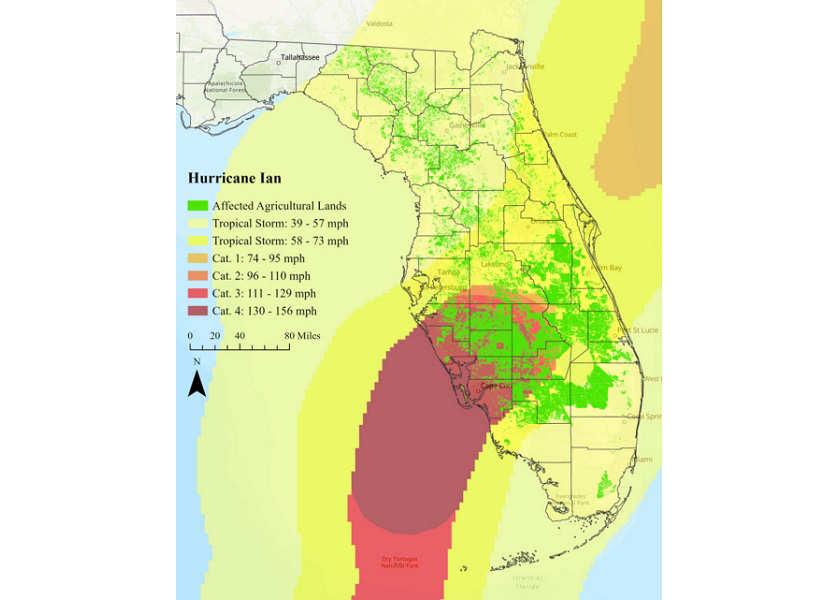'Heartbreaking' Hurricane Ian damage to Florida agriculture estimated up to $1.56B

Drawing comparisons to the damage wrought by Hurricane Irma in 2017, Hurricane Ian’s damage to Florida crops and livestock has been estimated by University of Florida economists from $787 million to $1.56 billion.
Vegetables and citrus were hard hit by Hurricane Ian in late September, according to the preliminary analysis, available online.
Despite heavy flooding prohibiting full assessments of some fields, the researchers predicted economic impacts to citrus, vegetables and livestock from Hurricane Ian, which hit southwest Florida Sept. 28.
Citrus crops are expected to sustain significant production losses ($147 million to $304 million), depending on the level of fruit drop, damage to branches, and impacts due to heavy precipitation and flooding, the report said. More than 375,000 acres of citrus — nearly all of Florida’s citrus acreage — was damaged in some way by the storm, according to the report. Before the storm, the total anticipated value of the Florida citrus crop was about $550 million, the report said.
Economists noted that production loss values do not include repair or replacement values associated with downed trees, which are expected to be significant in number, or damages to infrastructure such as irrigation equipment and buildings.
Vegetables and melons are expected to sustain significant production losses ($208 million to $394 million), economists said, with about 150,000 acres affected to at least some degree.
Impacts are heavily dependent on the ability for growers to replant damaged or destroyed crops, since the report said many vegetable crops in southwest Florida were still in planting season in this region. “Some growers delayed planting but those that had not are reporting wind damage as well as flooding, the severity of which depends on time since planting, sturdiness or hardiness of the plant, and the depth and duration of flooding,” the report said.
Livestock operations (beef and dairy cattle, horses, apiculture, etc.) and producers of animal products (milk, eggs, honey) are expected to suffer losses ($113 million to $222 million) due to damaged fencing, power outages and flooding, according to the report.
“Even though the coast — an area with comparatively less agricultural production than inland areas — bore some of the worst impacts of the storm, the strong winds and heavy rains battered a wide swath of the peninsula that includes over 5 million acres of agricultural land,” Christa Court, director of the program and assistant professor in the University of Florida/Institute of Agricultural Sciences food and resource economics department, said in a news release about the damage estimate. “This estimate only accounts for production losses, or changes in expected revenues for the current calendar or market year; citrus, for example, had not yet begun harvesting, and some fall vegetables, like tomatoes and peppers, were already planted.”
In a press briefing about the report, Court said University of Florida economists may have an update on hurricane damages by mid-November. Court said she had no data yet whether the hurricane will cause the spread of diseases like citrus greening.
“Our goal is to provide a rapid assessment on a credible range of the potential losses associated with Hurricane Ian,” Court said in the release. “As assessments are still ongoing, it’s not possible to narrow the range further at this time or to provide estimates for specific crops or commodities.”
Some commodities were already looking at lower expected production due to a hard freeze event in January that affected much of the same acreage, Court said in the release.
“Southwest counties that got hit the hardest by Hurricane Ian have remained in rescue and recovery mode; we anticipate our assessments will not be complete for several weeks,” Court said in the release. “Our preliminary estimate is a range, a wide range, to account for many of these unknowns. What isn’t destroyed might have diminished yield or quality, which will not be apparent for weeks or months, and then even more effects can appear in the long-term.”
Analyzing Hurricane Ian’s impacts remains complicated, she said in the release.
Hurricane Ian made landfall not far from 2017’s Hurricane Irma, but it cut across toward the east coast, rather than north through the entire peninsula. In addition, the release said Ian was a more powerful storm, bringing hurricane-strength (74 to 156 mph) winds to nearly 1.2 million acres of agricultural lands.
Florida Agriculture Commissioner Nikki Fried said in a statement she was not surprised by the estimated cost of the storm. "The impact on Florida’s affected commodities cannot be understated, especially the heartbreaking damage to Florida citrus, an industry already facing significant challenges,” Fried said in the statement. “This assessment, along with our own internal evaluation, is the first step in the rebuilding process and my department will continue to work with state and federal partners to support our producers throughout the recovery process.”







